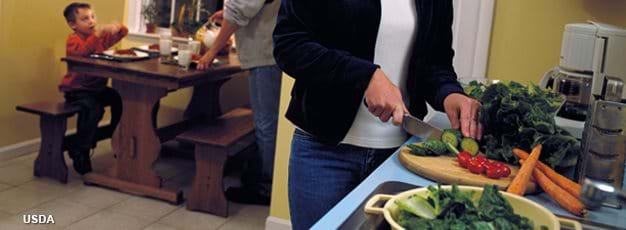Participating in SNAP Is Associated With Less Time Spent Eating

Many of the low-income households participating in USDA’s Supplemental Nutrition Assistance Program (SNAP) struggle with time constraints related to work and child care. The share of SNAP-participating households with earnings has risen over the last 15 years from 24 percent to 31 percent in fiscal 2012, and single-parent households made up 57 percent of all SNAP households with children in fiscal 2012. A recent study by ERS and University of Minnesota researchers found a significant relationship between SNAP participation and time spent preparing and eating meals.
Researchers used 2004-2010 data from the Current Population Survey’s Food Security Supplement and the American Time Use Survey to estimate the relationship between SNAP participation and time spent cooking and eating (at home and away from home) by comparing time allocation of SNAP-participant households with similar low-income, non-participant households matched by income level, household size, race, urban/rural residence, and the respondent’s sex and employment status.
During the study period, the average low-income household (both participants and non-participants) spent 35 minutes per day preparing food and 70 minutes per day eating. The study found that married couple households (with or without children) receiving SNAP benefits spend 15 fewer minutes preparing food than similar married households that do not receive SNAP. Increased food budgets provided by SNAP may allow participant households to purchase more expensive ready-to-eat or easily prepared food, thereby freeing up time usually allocated to food preparation.
In contrast, low-income SNAP households headed by a single adult (with or without children) spent 7 more minutes in food preparation time compared to similar single-adult households that do not participate in the program. The budgets of single-adult households, even when stretched by SNAP benefits, may not allow these households to substitute preparation time with more expensive ready-to-eat food items.
In both types of households, SNAP participation was associated with less time eating. Married participant households spent 8 fewer minutes eating than similar non-participant households, while single-adult SNAP households spent 9 fewer minutes eating than similar non-participant households. If decreased eating time is due to a greater frequency of less healthful “on-the-run” meals, these households may be compromising nutrition for convenience. The study’s findings suggest that time constraints as well as budget constraints play an important role in low-income households’ food choices.
“Time to eat? The relationship between food security and food-related time use”, Public Health Nutrition, Vol. 17, No. 1: pp. 66-72, July 2013


